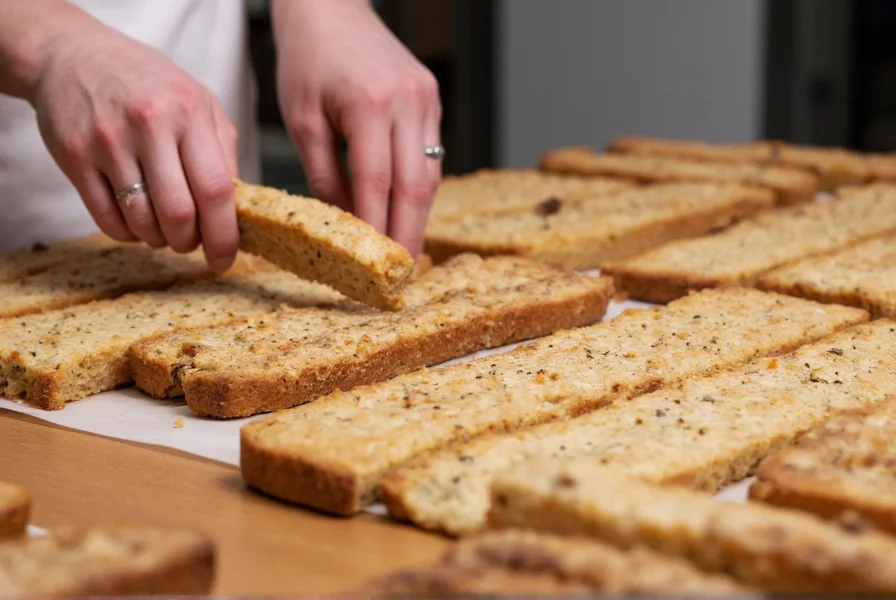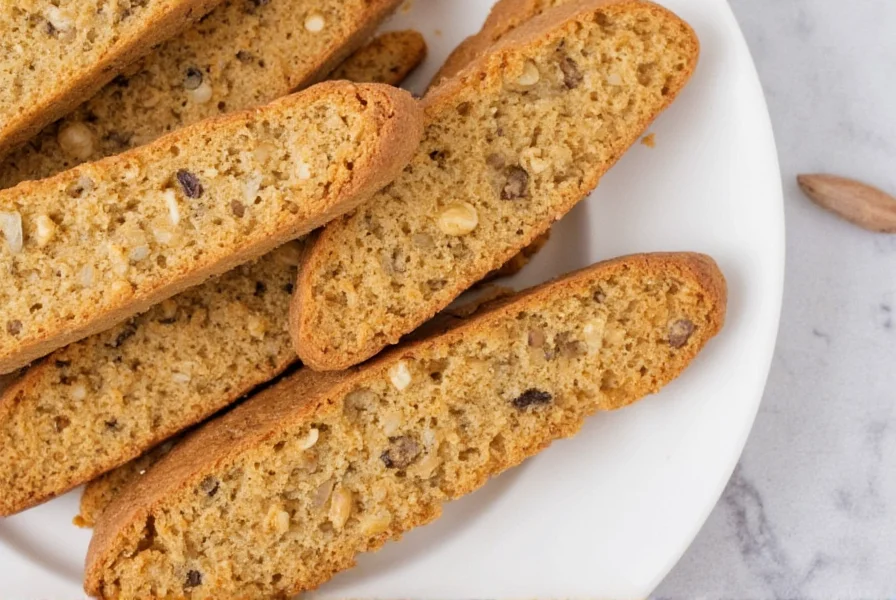Anise biscotti represent one of Italy's most cherished culinary traditions, offering a distinctive flavor profile that sets them apart from standard almond biscotti. These twice-baked cookies incorporate star anise or anise seeds, creating a subtle licorice-like flavor that perfectly complements coffee, dessert wines, and after-dinner drinks.
Historical Origins of Anise Biscotti
The history of biscotti traces back to ancient Roman times, with the name deriving from biscottus, meaning "twice-cooked" in Latin. This preservation technique created durable cookies that could last for months without spoiling, making them ideal provisions for Roman soldiers and sailors.
Anise flavoring became incorporated into biscotti recipes during the Renaissance period when trade routes brought exotic spices to Italian ports. Tuscan bakers discovered that the aromatic qualities of anise seeds complemented the nuttiness of almonds, creating what would become known as cantucci all'anice in traditional Italian baking.

Distinctive Characteristics of Authentic Anise Biscotti
What makes anise biscotti unique among the biscotti family? Several key characteristics define authentic versions:
| Characteristic | Standard Almond Biscotti | Anise Biscotti |
|---|---|---|
| Primary Flavoring | Almonds | Anise seeds or star anise |
| Flavor Profile | Nutty, sweet | Subtle licorice, aromatic |
| Traditional Pairing | Vin Santo | Vin Santo or espresso |
| Texture | Firm, crunchy | Slightly more brittle |
| Regional Origin | Tuscany | Tuscan coastal regions |
The anise flavoring creates a more complex taste experience that cuts through the sweetness of the cookie, providing a refreshing finish that makes these biscotti particularly suitable for after-dinner enjoyment.
The Science Behind Anise Flavor in Baking
Anise contains anethole, the same compound found in fennel and licorice, which creates that distinctive flavor profile. When baked, anethole's volatility means it releases its aromatic compounds gradually, creating a lingering flavor experience. This is why anise biscotti maintain their distinctive taste even after the twice-baking process that dries them thoroughly.
Professional bakers note that the timing of anise incorporation affects the final flavor. Adding ground anise seeds to the dry ingredients creates a more integrated flavor, while adding whole star anise to the dough provides intermittent bursts of flavor as you bite through the cookie.
Traditional Preparation Methods
Authentic anise biscotti preparation follows specific techniques developed over centuries. The dough typically contains:
- Almond flour or whole almonds
- Anise seeds (or occasionally star anise)
- Egg whites for structure
- Minimal sugar compared to American-style cookies
- No butter or oil (traditional versions)
The twice-baking process is crucial. First, the dough is formed into logs and baked until set but still soft. After cooling slightly, the logs are sliced and returned to the oven at a lower temperature to dry completely. This second bake creates the characteristic crunch that allows anise biscotti to withstand dipping without disintegrating.

Cultural Significance in Italian Dining
In Italy, anise biscotti serve a specific purpose in the dining experience. They're traditionally served after meals with Vin Santo, a Tuscan dessert wine. The ritual involves dipping the biscotti briefly into the wine, allowing the dry cookie to absorb some liquid while maintaining its structure.
This practice, called inzuppare, transforms the biscotti's texture and creates a harmonious flavor combination where the wine's sweetness balances the anise's slight bitterness. Many Italian families have their own variations of anise biscotti recipes passed down through generations, with subtle differences in anise quantity and preparation techniques.
Perfect Pairings for Anise Biscotti
While Vin Santo remains the traditional pairing, anise biscotti complement various beverages:
- Espresso or ristretto - The intense coffee flavor balances the anise
- Limoncello or other citrus liqueurs - Creates a refreshing contrast
- Moscato d'Asti - The sweet, bubbly wine complements the licorice notes
- Herbal teas - Particularly mint or chamomile varieties
For optimal enjoyment, serve anise biscotti at room temperature. The dry texture requires proper storage in airtight containers to maintain their characteristic crunch. When stored correctly, authentic anise biscotti can remain fresh for up to four weeks.
Regional Variations Across Italy
While Tuscan anise biscotti represent the classic version, regional variations exist throughout Italy:
- Ligurian version - Often includes pine nuts alongside almonds
- Sicilian interpretation - Sometimes incorporates citrus zest with the anise
- Northern Italian style - May include a touch of honey for additional complexity
- Coastal variations - Occasionally feature fennel pollen as a complementary flavor
These regional differences reflect local ingredients and culinary traditions while maintaining the essential anise flavor profile that defines this biscotti variety.
Modern Interpretations and Serving Suggestions
Contemporary bakers have expanded traditional anise biscotti applications while respecting their heritage. Some creative serving suggestions include:
- Crumbling over vanilla gelato for an Italian-inspired dessert
- Pairing with strong cheeses like pecorino for a savory-sweet combination
- Using as a base for tiramisu with espresso and mascarpone
- Serving alongside chocolate for a sophisticated dessert course
When enjoying anise biscotti at home, remember that proper storage is essential. Keep them in an airtight container away from moisture. If they become too hard, place a piece of apple in the container for a few hours to restore some flexibility while maintaining structural integrity for dipping.
What makes anise biscotti different from regular biscotti?
Anise biscotti contain anise seeds or star anise, which gives them a distinctive licorice-like flavor profile that sets them apart from traditional almond biscotti. This aromatic quality makes them particularly suitable for pairing with Vin Santo or espresso, as the anise flavor complements these beverages exceptionally well.
How should I properly store anise biscotti to maintain freshness?
Store anise biscotti in an airtight container at room temperature away from moisture and direct sunlight. Properly stored, they can maintain their ideal crunchy texture for up to four weeks. Avoid refrigeration, as the humidity can soften the biscotti and compromise their dipping quality.
Can I make anise biscotti without almonds for nut allergies?
Yes, traditional Tuscan biscotti can be adapted for nut allergies by substituting the almonds with additional flour and perhaps a small amount of toasted sesame seeds for texture. The anise flavor remains the star, though the texture will be slightly different without the almonds' natural oils and crunch.
Why is anise used in biscotti rather than other spices?
Anise has been used in Italian baking for centuries because its flavor profile complements the dry, crunchy texture of biscotti perfectly. The subtle licorice notes cut through the sweetness and provide a refreshing finish that makes these cookies ideal for after-dinner enjoyment. Additionally, anise was historically more accessible along Italian trade routes than many other spices.
What's the proper technique for dipping anise biscotti?
The traditional Italian technique called 'inzuppare' involves briefly dipping just the tip of the biscotti into your beverage for 2-3 seconds. This allows the dry cookie to absorb some liquid while maintaining its structure. Over-dipping will cause the biscotti to disintegrate. The ideal result is a cookie that's slightly softened on the dipped end but still crunchy throughout the rest.











 浙公网安备
33010002000092号
浙公网安备
33010002000092号 浙B2-20120091-4
浙B2-20120091-4